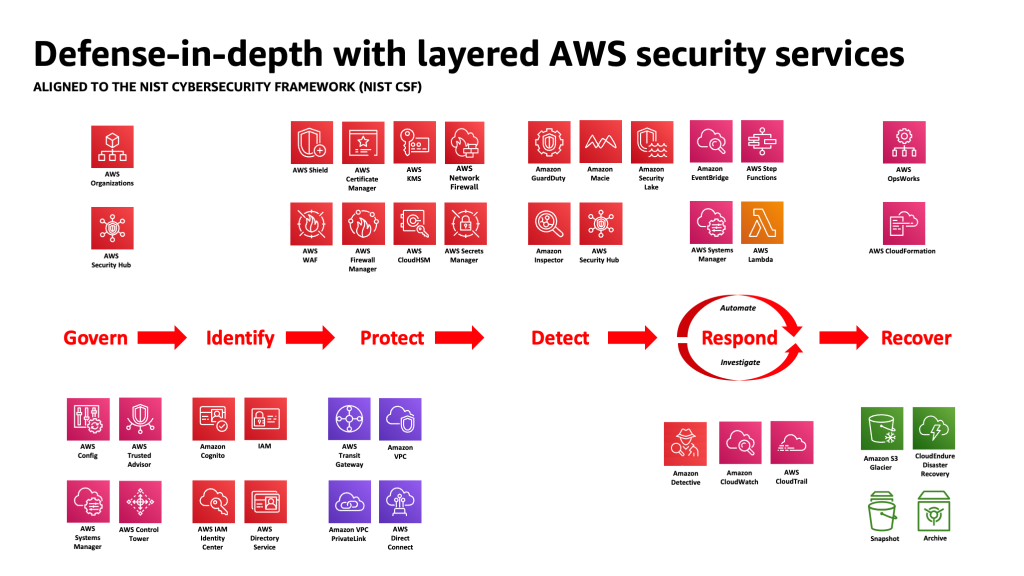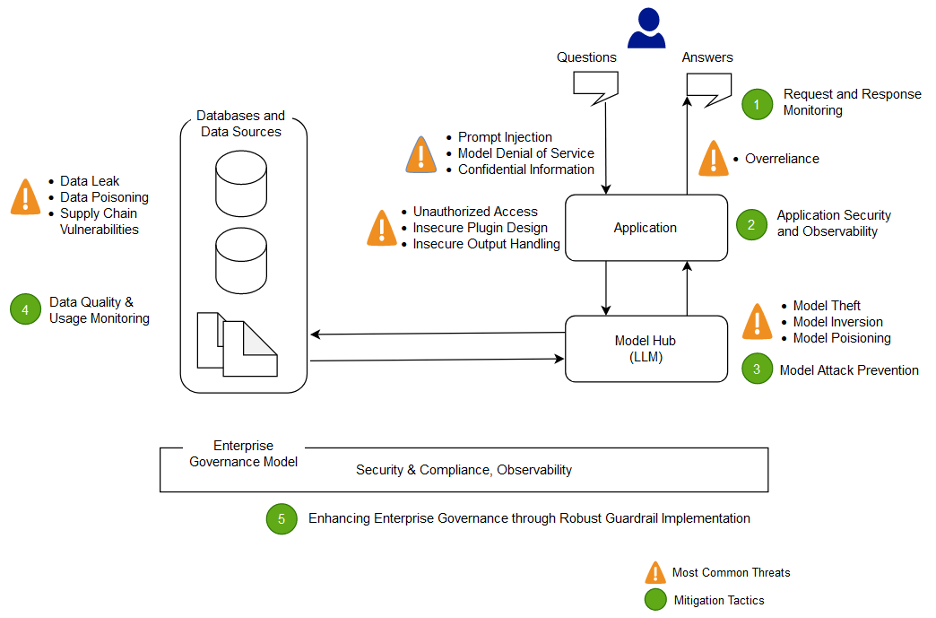Generative artificial intelligence (ai) applications built around large language models (LLMs) have demonstrated the potential to create and accelerate economic value for businesses. Examples of applications include conversational search, customer support agent assistance, customer support analytics, self-service virtual assistants, chatbots, rich media generation, content moderation, coding companions to accelerate secure, high-performance software development, deeper insights from multimodal content sources, acceleration of your organization’s security investigations and mitigations, and much more. Many customers are looking for guidance on how to manage security, privacy, and compliance as they develop generative ai applications. Understanding and addressing LLM vulnerabilities, threats, and risks during the design and architecture phases helps teams focus on maximizing the economic and productivity benefits generative ai can bring. Being aware of risks fosters transparency and trust in generative ai applications, encourages increased observability, helps to meet compliance requirements, and facilitates informed decision-making by leaders.
The goal of this post is to empower ai and machine learning (ML) engineers, data scientists, solutions architects, security teams, and other stakeholders to have a common mental model and framework to apply security best practices, allowing ai/ML teams to move fast without trading off security for speed. Specifically, this post seeks to help ai/ML and data scientists who may not have had previous exposure to security principles gain an understanding of core security and privacy best practices in the context of developing generative ai applications using LLMs. We also discuss common security concerns that can undermine trust in ai, as identified by the Open Worldwide Application Security Project (OWASP) Top 10 for LLM Applications, and show ways you can use AWS to increase your security posture and confidence while innovating with generative ai.
This post provides three guided steps to architect risk management strategies while developing generative ai applications using LLMs. We first delve into the vulnerabilities, threats, and risks that arise from the implementation, deployment, and use of LLM solutions, and provide guidance on how to start innovating with security in mind. We then discuss how building on a secure foundation is essential for generative ai. Lastly, we connect these together with an example LLM workload to describe an approach towards architecting with defense-in-depth security across trust boundaries.
By the end of this post, ai/ML engineers, data scientists, and security-minded technologists will be able to identify strategies to architect layered defenses for their generative ai applications, understand how to map OWASP Top 10 for LLMs security concerns to some corresponding controls, and build foundational knowledge towards answering the following top AWS customer question themes for their applications:
- What are some of the common security and privacy risks with using generative ai based on LLMs in my applications that I can most impact with this guidance?
- What are some ways to implement security and privacy controls in the development lifecycle for generative ai LLM applications on AWS?
- What operational and technical best practices can I integrate into how my organization builds generative ai LLM applications to manage risk and increase confidence in generative ai applications using LLMs?
Improve security outcomes while developing generative ai
Innovation with generative ai using LLMs requires starting with security in mind to develop organizational resiliency, build on a secure foundation, and integrate security with a defense in depth security approach. Security is a shared responsibility between AWS and AWS customers. All the principles of the AWS Shared Responsibility Model are applicable to generative ai solutions. Refresh your understanding of the AWS Shared Responsibility Model as it applies to infrastructure, services, and data when you build LLM solutions.
Start with security in mind to develop organizational resiliency
Start with security in mind to develop organizational resiliency for developing generative ai applications that meet your security and compliance objectives. Organizational resiliency draws on and extends the definition of resiliency in the AWS Well-Architected Framework to include and prepare for the ability of an organization to recover from disruptions. Consider your security posture, governance, and operational excellence when assessing overall readiness to develop generative ai with LLMs and your organizational resiliency to any potential impacts. As your organization advances its use of emerging technologies such as generative ai and LLMs, overall organizational resiliency should be considered as a cornerstone of a layered defensive strategy to protect assets and lines of business from unintended consequences.
Organizational resiliency matters substantially for LLM applications
Although all risk management programs can benefit from resilience, organizational resiliency matters substantially for generative ai. Five of the OWASP-identified top 10 risks for LLM applications rely on defining architectural and operational controls and enforcing them at an organizational scale in order to manage risk. These five risks are insecure output handling, supply chain vulnerabilities, sensitive information disclosure, excessive agency, and overreliance. Begin increasing organizational resiliency by socializing your teams to consider ai, ML, and generative ai security a core business requirement and top priority throughout the whole lifecycle of the product, from inception of the idea, to research, to the application’s development, deployment, and use. In addition to awareness, your teams should take action to account for generative ai in governance, assurance, and compliance validation practices.
Build organizational resiliency around generative ai
Organizations can start adopting ways to build their capacity and capabilities for ai/ML and generative ai security within their organizations. You should begin by extending your existing security, assurance, compliance, and development programs to account for generative ai.
The following are the five key areas of interest for organizational ai, ML, and generative ai security:
- Understand the ai/ML security landscape
- Include diverse perspectives in security strategies
- Take action proactively for securing research and development activities
- Align incentives with organizational outcomes
- Prepare for realistic security scenarios in ai/ML and generative ai
Develop a threat model throughout your generative ai Lifecycle
Organizations building with generative ai should focus on risk management, not risk elimination, and include threat modeling in and business continuity planning the planning, development, and operations of generative ai workloads. Work backward from production use of generative ai by developing a threat model for each application using traditional security risks as well as generative ai-specific risks. Some risks may be acceptable to your business, and a threat modeling exercise can help your company identify what your acceptable risk appetite is. For example, your business may not require 99.999% uptime on a generative ai application, so the additional recovery time associated to recovery using AWS Backup with Amazon S3 Glacier may be an acceptable risk. Conversely, the data in your model may be extremely sensitive and highly regulated, so deviation from AWS Key Management Service (AWS KMS) customer managed key (CMK) rotation and use of AWS Network Firewall to help enforce Transport Layer Security (TLS) for ingress and egress traffic to protect against data exfiltration may be an unacceptable risk.
Evaluate the risks (inherent vs. residual) of using the generative ai application in a production setting to identify the right foundational and application-level controls. Plan for rollback and recovery from production security events and service disruptions such as prompt injection, training data poisoning, model denial of service, and model theft early on, and define the mitigations you will use as you define application requirements. Learning about the risks and controls that need to be put in place will help define the best implementation approach for building a generative ai application, and provide stakeholders and decision-makers with information to make informed business decisions about risk. If you are unfamiliar with the overall ai and ML workflow, start by reviewing 7 ways to improve security of your machine learning workloads to increase familiarity with the security controls needed for traditional ai/ML systems.
Just like building any ML application, building a generative ai application involves going through a set of research and development lifecycle stages. You may want to review the AWS Generative ai Security Scoping Matrix to help build a mental model to understand the key security disciplines that you should consider depending on which generative ai solution you select.
Generative ai applications using LLMs are typically developed and operated following ordered steps:
- Application requirements – Identify use case business objectives, requirements, and success criteria
- Model selection – Select a foundation model that aligns with use case requirements
- Model adaptation and fine-tuning – Prepare data, engineer prompts, and fine-tune the model
- Model evaluation – Evaluate foundation models with use case-specific metrics and select the best-performing model
- Deployment and integration – Deploy the selected foundation model on your optimized infrastructure and integrate with your generative ai application
- Application monitoring – Monitor application and model performance to enable root cause analysis
Ensure teams understand the critical nature of security as part of the design and architecture phases of your software development lifecycle on Day 1. This means discussing security at each layer of your stack and lifecycle, and positioning security and privacy as enablers to achieving business objectives.Architect controls for threats before you launch your LLM application, and consider whether the data and information you will use for model adaptation and fine-tuning warrants controls implementation in the research, development, and training environments. As part of quality assurance tests, introduce synthetic security threats (such as attempting to poison training data, or attempting to extract sensitive data through malicious prompt engineering) to test out your defenses and security posture on a regular basis.
Additionally, stakeholders should establish a consistent review cadence for production ai, ML, and generative ai workloads and set organizational priority on understanding trade-offs between human and machine control and error prior to launch. Validating and assuring that these trade-offs are respected in the deployed LLM applications will increase the likelihood of risk mitigation success.
Build generative ai applications on secure cloud foundations
At AWS, security is our top priority. AWS is architected to be the most secure global cloud infrastructure on which to build, migrate, and manage applications and workloads. This is backed by our deep set of over 300 cloud security tools and the trust of our millions of customers, including the most security-sensitive organizations like government, healthcare, and financial services. When building generative ai applications using LLMs on AWS, you gain security benefits from the secure, reliable, and flexible AWS Cloud computing environment.
Use an AWS global infrastructure for security, privacy, and compliance
When you develop data-intensive applications on AWS, you can benefit from an AWS global Region infrastructure, architected to provide capabilities to meet your core security and compliance requirements. This is reinforced by our AWS Digital Sovereignty Pledge, our commitment to offering you the most advanced set of sovereignty controls and features available in the cloud. We are committed to expanding our capabilities to allow you to meet your digital sovereignty needs, without compromising on the performance, innovation, security, or scale of the AWS Cloud. To simplify implementation of security and privacy best practices, consider using reference designs and infrastructure as code resources such as the AWS Security Reference Architecture (AWS SRA) and the AWS Privacy Reference Architecture (AWS PRA). Read more about architecting privacy solutions, sovereignty by design, and compliance on AWS and use services such as AWS Config, AWS Artifact, and AWS Audit Manager to support your privacy, compliance, audit, and observability needs.
Understand your security posture using AWS Well-Architected and Cloud Adoption Frameworks
AWS offers best practice guidance developed from years of experience supporting customers in architecting their cloud environments with the AWS Well-Architected Framework and in evolving to realize business value from cloud technologies with the AWS Cloud Adoption Framework (AWS CAF). Understand the security posture of your ai, ML, and generative ai workloads by performing a Well-Architected Framework review. Reviews can be performed using tools like the AWS Well-Architected Tool, or with the help of your AWS team through AWS Enterprise Support. The AWS Well-Architected Tool automatically integrates insights from AWS Trusted Advisor to evaluate what best practices are in place and what opportunities exist to improve functionality and cost-optimization. The AWS Well-Architected Tool also offers customized lenses with specific best practices such as the Machine Learning Lens for you to regularly measure your architectures against best practices and identify areas for improvement. Checkpoint your journey on the path to value realization and cloud maturity by understanding how AWS customers adopt strategies to develop organizational capabilities in the AWS Cloud Adoption Framework for artificial intelligence, Machine Learning, and Generative ai. You might also find benefit in understanding your overall cloud readiness by participating in an AWS Cloud Readiness Assessment. AWS offers additional opportunities for engagement—ask your AWS account team for more information on how to get started with the Generative ai Innovation Center.
Accelerate your security and ai/ML learning with best practices guidance, training, and certification
AWS also curates recommendations from Best Practices for Security, Identity, & Compliance and AWS Security Documentation to help you identify ways to secure your training, development, testing, and operational environments. If you’re just getting started, dive deeper on security training and certification, consider starting with AWS Security Fundamentals and the AWS Security Learning Plan. You can also use the AWS Security Maturity Model to help guide you finding and prioritizing the best activities at different phases of maturity on AWS, starting with quick wins, through foundational, efficient, and optimized stages. After you and your teams have a basic understanding of security on AWS, we strongly recommend reviewing How to approach threat modeling and then leading a threat modeling exercise with your teams starting with the Threat Modeling For Builders Workshop training program. There are many other AWS Security training and certification resources available.
Apply a defense-in-depth approach to secure LLM applications
Applying a defense-in-depth security approach to your generative ai workloads, data, and information can help create the best conditions to achieve your business objectives. Defense-in-depth security best practices mitigate many of the common risks that any workload faces, helping you and your teams accelerate your generative ai innovation. A defense-in-depth security strategy uses multiple redundant defenses to protect your AWS accounts, workloads, data, and assets. It helps make sure that if any one security control is compromised or fails, additional layers exist to help isolate threats and prevent, detect, respond, and recover from security events. You can use a combination of strategies, including AWS services and solutions, at each layer to improve the security and resiliency of your generative ai workloads.
Many AWS customers align to industry standard frameworks, such as the NIST Cybersecurity Framework. This framework helps ensure that your security defenses have protection across the pillars of Identify, Protect, Detect, Respond, Recover, and most recently added, Govern. This framework can then easily map to AWS Security services and those from integrated third parties as well to help you validate adequate coverage and policies for any security event your organization encounters.
Defense in depth: Secure your environment, then add enhanced ai/ML-specific security and privacy capabilities
A defense-in-depth strategy should start by protecting your accounts and organization first, and then layer on the additional built-in security and privacy enhanced features of services such as Amazon Bedrock and Amazon SageMaker. Amazon has over 30 services in the Security, Identity, and Compliance portfolio which are integrated with AWS ai/ML services, and can be used together to help secure your workloads, accounts, organization. To properly defend against the OWASP Top 10 for LLM, these should be used together with the AWS ai/ML services.
Start by implementing a policy of least privilege, using services like IAM Access Analyzer to look for overly permissive accounts, roles, and resources to restrict access using short-termed credentials. Next, make sure that all data at rest is encrypted with AWS KMS, including considering the use of CMKs, and all data and models are versioned and backed up using Amazon Simple Storage Service (Amazon S3) versioning and applying object-level immutability with Amazon S3 Object Lock. Protect all data in transit between services using AWS Certificate Manager and/or AWS Private CA, and keep it within VPCs using AWS PrivateLink. Define strict data ingress and egress rules to help protect against manipulation and exfiltration using VPCs with AWS Network Firewall policies. Consider inserting AWS Web Application Firewall (AWS WAF) in front to protect web applications and APIs from malicious bots, SQL injection attacks, cross-site scripting (XSS), and account takeovers with Fraud Control. Logging with AWS CloudTrail, Amazon Virtual Private Cloud (Amazon VPC) flow logs, and Amazon Elastic Kubernetes Service (Amazon EKS) audit logs will help provide forensic review of each transaction available to services such as Amazon Detective. You can use Amazon Inspector to automate vulnerability discovery and management for Amazon Elastic Compute Cloud (Amazon EC2) instances, containers, AWS Lambda functions, and identify the network reachability of your workloads. Protect your data and models from suspicious activity using Amazon GuardDuty’s ML-powered threat models and intelligence feeds, and enabling its additional features for EKS Protection, ECS Protection, S3 Protection, RDS Protection, Malware Protection, Lambda Protection, and more. You can use services like AWS Security Hub to centralize and automate your security checks to detect deviations from security best practices and accelerate investigation and automate remediation of security findings with playbooks. You can also consider implementing a zero trust architecture on AWS to further increase fine-grained authentication and authorization controls for what human users or machine-to-machine processes can access on a per-request basis. Also consider using Amazon Security Lake to automatically centralize security data from AWS environments, SaaS providers, on premises, and cloud sources into a purpose-built data lake stored in your account. With Security Lake, you can get a more complete understanding of your security data across your entire organization.
After your generative ai workload environment has been secured, you can layer in ai/ML-specific features, such as Amazon SageMaker Data Wrangler to identify potential bias during data preparation and Amazon SageMaker Clarify to detect bias in ML data and models. You can also use Amazon SageMaker Model Monitor to evaluate the quality of SageMaker ML models in production, and notify you when there is drift in data quality, model quality, and feature attribution. These AWS ai/ML services working together (including SageMaker working with Amazon Bedrock) with AWS Security services can help you identify potential sources of natural bias and protect against malicious data tampering. Repeat this process for each of the OWASP Top 10 for LLM vulnerabilities to ensure you’re maximizing the value of AWS services to implement defense in depth to protect your data and workloads.
As AWS Enterprise Strategist Clarke Rodgers wrote in his blog post “CISO Insight: Every AWS Service Is A Security Service”, “I would argue that virtually every service within the AWS cloud either enables a security outcome by itself, or can be used (alone or in conjunction with one or more services) by customers to achieve a security, risk, or compliance objective.” And “Customer Chief Information Security Officers (CISOs) (or their respective teams) may want to take the time to ensure that they are well versed with all AWS services because there may be a security, risk, or compliance objective that can be met, even if a service doesn’t fall into the ‘Security, Identity, and Compliance’ category.”
Layer defenses at trust boundaries in LLM applications
When developing generative ai-based systems and applications, you should consider the same concerns as with any other ML application, as mentioned in the MITRE ATLAS Machine Learning Threat Matrix, such as being mindful of software and data component origins (such as performing an open source software audit, reviewing software bill of materials (SBOMs), and analyzing data workflows and API integrations) and implementing necessary protections against LLM supply chain threats. Include insights from industry frameworks, and be aware of ways to use multiple sources of threat intelligence and risk information to adjust and extend your security defenses to account for ai, ML, and generative ai security risks that are emergent and not included in traditional frameworks. Seek out companion information on ai-specific risks from industry, defense, governmental, international, and academic sources, because new threats emerge and evolve in this space regularly and companion frameworks and guides are updated frequently. For example, when using a Retrieval Augmented Generation (RAG) model, if the model doesn’t include the data it needs, it may request it from an external data source for using during inferencing and fine-tuning. The source that it queries may be outside of your control, and can be a potential source of compromise in your supply chain. A defense-in-depth approach should be extended towards external sources to establish trust, authentication, authorization, access, security, privacy, and accuracy of the data it is accessing. To dive deeper, read “Build a secure enterprise application with Generative ai and RAG using Amazon SageMaker JumpStart”
Analyze and mitigate risk in your LLM applications
In this section, we analyze and discuss some risk mitigation techniques based on trust boundaries and interactions, or distinct areas of the workload with similar appropriate controls scope and risk profile. In this sample architecture of a chatbot application, there are five trust boundaries where controls are demonstrated, based on how AWS customers commonly build their LLM applications. Your LLM application may have more or fewer definable trust boundaries. In the following sample architecture, these trust boundaries are defined as:
- User interface interactions (request and response)
- Application interactions
- Model interactions
- Data interactions
- Organizational interactions and use
User interface interactions: Develop request and response monitoring
Detect and respond to cyber incidents related to generative ai in a timely manner by evaluating a strategy to address risk from the inputs and outputs of the generative ai application. For example, additional monitoring for behaviors and data outflow may need to be instrumented to detect sensitive information disclosure outside your domain or organization, in the case that it is used in the LLM application.
Generative ai applications should still uphold the standard security best practices when it comes to protecting data. Establish a secure data perimeter and secure sensitive data stores. Encrypt data and information used for LLM applications at rest and in transit. Protect data used to train your model from training data poisoning by understanding and controlling which users, processes, and roles are allowed to contribute to the data stores, as well as how data flows in the application, monitor for bias deviations, and using versioning and immutable storage in storage services such as Amazon S3. Establish strict data ingress and egress controls using services like AWS Network Firewall and AWS VPCs to protect against suspicious input and the potential for data exfiltration.
During the training, retraining, or fine-tuning process, you should be aware of any sensitive data that is utilized. After data is used during one of these processes, you should plan for a scenario where any user of your model suddenly becomes able to extract the data or information back out by utilizing prompt injection techniques. Understand the risks and benefits of using sensitive data in your models and inferencing. Implement robust authentication and authorization mechanisms for establishing and managing fine-grained access permissions, which don’t rely on LLM application logic to prevent disclosure. User-controlled input to a generative ai application has been demonstrated under some conditions to be able to provide a vector to extract information from the model or any non-user-controlled parts of the input. This can occur via prompt injection, where the user provides input that causes the output of the model to deviate from the expected guardrails of the LLM application, including providing clues to the datasets that the model was originally trained on.
Implement user-level access quotas for users providing input and receiving output from a model. You should consider approaches that don’t allow anonymous access under conditions where the model training data and information is sensitive, or where there is risk from an adversary training a facsimile of your model based on their input and your aligned model output. In general, if part of the input to a model consists of arbitrary user-provided text, consider the output to be susceptible to prompt injection, and accordingly ensure use of the outputs includes implemented technical and organizational countermeasures to mitigate insecure output handling, excessive agency, and overreliance. In the example earlier related to filtering for malicious input using AWS WAF, consider building a filter in front of your application for such potential misuse of prompts, and develop a policy for how to handle and evolve those as your model and data grows. Also consider a filtered review of the output before it is returned to the user to ensure it meets quality, accuracy, or content moderation standards. You may want to further customize this for your organization’s needs with an additional layer of control on inputs and outputs in front of your models to mitigate suspicious traffic patterns.
Application interactions: Application security and observability
Review your LLM application with attention to how a user could utilize your model to bypass standard authorization to a downstream tool or toolchain that they don’t have authorization to access or use. Another concern at this layer involves accessing external data stores by using a model as an attack mechanism using unmitigated technical or organizational LLM risks. For example, if your model is trained to access certain data stores that could contain sensitive data, you should ensure that you have proper authorization checks between your model and the data stores. Use immutable attributes about users that don’t come from the model when performing authorization checks. Unmitigated insecure output handling, insecure plugin design, and excessive agency can create conditions where a threat actor may use a model to trick the authorization system into escalating effective privileges, leading to a downstream component believing the user is authorized to retrieve data or take a specific action.
When implementing any generative ai plugin or tool, it is imperative to examine and comprehend the level of access being granted, as well as scrutinize the access controls that have been configured. Using unmitigated insecure generative ai plugins may render your system susceptible to supply chain vulnerabilities and threats, potentially leading to malicious actions, including running remote code.
Model interactions: Model attack prevention
You should be aware of the origin of any models, plugins, tools, or data you use, in order to evaluate and mitigate against supply chain vulnerabilities. For example, some common model formats permit the embedding of arbitrary runnable code in the models themselves. Use package mirrors, scanning, and additional inspections as relevant to your organizations security goals.
The datasets you train and fine-tune your models on must also be reviewed. If you further automatically fine-tune a model based on user feedback (or other end-user-controllable information), you must consider if a malicious threat actor could change the model arbitrarily based on manipulating their responses and achieve training data poisoning.
Data interactions: Monitor data quality and usage
Generative ai models such as LLMs generally work well because they have been trained on a large amount of data. Although this data helps LLMs complete complex tasks, it also can expose your system to risk of training data poisoning, which occurs when inappropriate data is included or omitted inside a training dataset that can alter a model’s behavior. To mitigate this risk, you should look at your supply chain and understand the data review process for your system before it’s used inside your model. Although the training pipeline is a prime source for data poisoning, you should also look at how your model gets data, such as in a RAG model or data lake, and if the source of that data is trusted and protected. Use AWS Security services such as AWS Security Hub, Amazon GuardDuty, and Amazon Inspector to help continuously monitor for suspicious activity in Amazon EC2, Amazon EKS, Amazon S3, Amazon Relational Database Service (Amazon RDS), and network access that may be indicators of emerging threats, and use Detective to visualize security investigations. Also consider using services such as Amazon Security Lake to accelerate security investigations by creating a purpose-built data lake to automatically centralize security data from AWS environments, SaaS providers, on premises, and cloud sources which contribute to your ai/ML workloads.
Organizational interactions: Implement enterprise governance guardrails for generative ai
Identify risks associated with the use of generative ai for your businesses. You should build your organization’s risk taxonomy and conduct risk assessments to make informed decisions when deploying generative ai solutions. Develop a business continuity plan (BCP) that includes ai, ML, and generative ai workloads and that can be enacted quickly to replace the lost functionality of an impacted or offline LLM application to meet your SLAs.
Identify process and resource gaps, inefficiencies, and inconsistencies, and improve awareness and ownership across your business. Threat model all generative ai workloads to identify and mitigate potential security threats that may lead to business-impacting outcomes, including unauthorized access to data, denial of service, and resource misuse. Take advantage of the new AWS Threat Composer Modeling Tool to help reduce time-to-value when performing threat modeling. Later in your development cycles, consider including introducing security chaos engineering fault injection experiments to create real-world conditions to understand how your system will react to unknowns and build confidence in the system’s resiliency and security.
Include diverse perspectives in developing security strategies and risk management mechanisms to ensure adherence and coverage for ai/ML and generative security across all job roles and functions. Bring a security mindset to the table from the inception and research of any generative ai application to align on requirements. If you need extra assistance from AWS, ask your AWS account manager to make sure that there is equal support by requesting AWS Solutions Architects from AWS Security and ai/ML to help in tandem.
Ensure that your security organization routinely takes actions to foster communication around both risk awareness and risk management understanding among generative ai stakeholders such as product managers, software developers, data scientists, and executive leadership, allowing threat intelligence and controls guidance to reach the teams that may be impacted. Security organizations can support a culture of responsible disclosure and iterative improvement by participating in discussions and bringing new ideas and information to generative ai stakeholders that relate to their business objectives. Learn more about our commitment to Responsible ai and additional responsible ai resources to help our customers.
Gain advantage in enabling better organizational posture for generative ai by unblocking time to value in the existing security processes of your organization. Proactively evaluate where your organization may require processes that are overly burdensome given the generative ai security context and refine these to provide developers and scientists a clear path to launch with the correct controls in place.
Assess where there may be opportunities to align incentives, derisk, and provide a clear line of sight on the desired outcomes. Update controls guidance and defenses to meet the evolving needs of ai/ML and generative ai application development to reduce confusion and uncertainty that can cost development time, increase risk, and increase impact.
Ensure that stakeholders who are not security experts are able to both understand how organizational governance, policies, and risk management steps apply to their workloads, as well as apply risk management mechanisms. Prepare your organization to respond to realistic events and scenarios that may occur with generative ai applications, and ensure that generative ai builder roles and response teams are aware of escalation paths and actions in case of concern for any suspicious activity.
Conclusion
To successfully commercialize innovation with any new and emerging technology requires starting with a security-first mindset, building on a secure infrastructure foundation, and thinking about how to further integrate security at each level of the technology stack early with a defense-in-depth security approach. This includes interactions at multiple layers of your technology stack, and integration points within your digital supply chain, to ensure organizational resiliency. Although generative ai introduces some new security and privacy challenges, if you follow fundamental security best practices such as using defense-in-depth with layered security services, you can help protect your organization from many common issues and evolving threats. You should implement layered AWS Security services across your generative ai workloads and larger organization, and focus on integration points in your digital supply chains to secure your cloud environments. Then you can use the enhanced security and privacy capabilities in AWS ai/ML services such as Amazon SageMaker and Amazon Bedrock to add further layers of enhanced security and privacy controls to your generative ai applications. Embedding security from the start will make it faster, easier, and more cost-effective to innovate with generative ai, while simplifying compliance. This will help you increase controls, confidence, and observability to your generative ai applications for your employees, customers, partners, regulators, and other concerned stakeholders.
Additional references
- Industry standard frameworks for ai/ML-specific risk management and security:
About the authors
 Christopher Rae is a Principal Worldwide Security GTM Specialist focused on developing and executing strategic initiatives that accelerate and scale adoption of AWS security services. He is passionate about the intersection of cybersecurity and emerging technologies, with 20+ years of experience in global strategic leadership roles delivering security solutions to media, entertainment, and telecom customers. He recharges through reading, traveling, food and wine, discovering new music, and advising early-stage startups.
Christopher Rae is a Principal Worldwide Security GTM Specialist focused on developing and executing strategic initiatives that accelerate and scale adoption of AWS security services. He is passionate about the intersection of cybersecurity and emerging technologies, with 20+ years of experience in global strategic leadership roles delivering security solutions to media, entertainment, and telecom customers. He recharges through reading, traveling, food and wine, discovering new music, and advising early-stage startups.
 Elijah Winter is a Senior Security Engineer in Amazon Security, holding a BS in Cyber Security Engineering and infused with a love for Harry Potter. Elijah excels in identifying and addressing vulnerabilities in ai systems, blending technical expertise with a touch of wizardry. Elijah designs tailored security protocols for ai ecosystems, bringing a magical flair to digital defenses. Integrity driven, Elijah has a security background in both public and commercial sector organizations focused on protecting trust.
Elijah Winter is a Senior Security Engineer in Amazon Security, holding a BS in Cyber Security Engineering and infused with a love for Harry Potter. Elijah excels in identifying and addressing vulnerabilities in ai systems, blending technical expertise with a touch of wizardry. Elijah designs tailored security protocols for ai ecosystems, bringing a magical flair to digital defenses. Integrity driven, Elijah has a security background in both public and commercial sector organizations focused on protecting trust.
 Ram Vittal is a Principal ML Solutions Architect at AWS. He has over 3 decades of experience architecting and building distributed, hybrid, and cloud applications. He is passionate about building secure and scalable ai/ML and big data solutions to help enterprise customers with their cloud adoption and optimization journey to improve their business outcomes. In his spare time, he rides his motorcycle and walks with his 3-year-old Sheepadoodle!
Ram Vittal is a Principal ML Solutions Architect at AWS. He has over 3 decades of experience architecting and building distributed, hybrid, and cloud applications. He is passionate about building secure and scalable ai/ML and big data solutions to help enterprise customers with their cloud adoption and optimization journey to improve their business outcomes. In his spare time, he rides his motorcycle and walks with his 3-year-old Sheepadoodle!
 Navneet Tuteja is a Data Specialist at Amazon Web Services. Before joining AWS, Navneet worked as a facilitator for organizations seeking to modernize their data architectures and implement comprehensive ai/ML solutions. She holds an engineering degree from Thapar University, as well as a master’s degree in statistics from Texas A&M University.
Navneet Tuteja is a Data Specialist at Amazon Web Services. Before joining AWS, Navneet worked as a facilitator for organizations seeking to modernize their data architectures and implement comprehensive ai/ML solutions. She holds an engineering degree from Thapar University, as well as a master’s degree in statistics from Texas A&M University.
 Emily Soward is a Data Scientist with AWS Professional Services. She holds a Master of Science with Distinction in artificial intelligence from the University of Edinburgh in Scotland, United Kingdom with emphasis on Natural Language Processing (NLP). Emily has served in applied scientific and engineering roles focused on ai-enabled product research and development, operational excellence, and governance for ai workloads running at organizations in the public and private sector. She contributes to customer guidance as an AWS Senior Speaker and recently, as an author for AWS Well-Architected in the Machine Learning Lens.
Emily Soward is a Data Scientist with AWS Professional Services. She holds a Master of Science with Distinction in artificial intelligence from the University of Edinburgh in Scotland, United Kingdom with emphasis on Natural Language Processing (NLP). Emily has served in applied scientific and engineering roles focused on ai-enabled product research and development, operational excellence, and governance for ai workloads running at organizations in the public and private sector. She contributes to customer guidance as an AWS Senior Speaker and recently, as an author for AWS Well-Architected in the Machine Learning Lens.
 NEWSLETTER
NEWSLETTER







